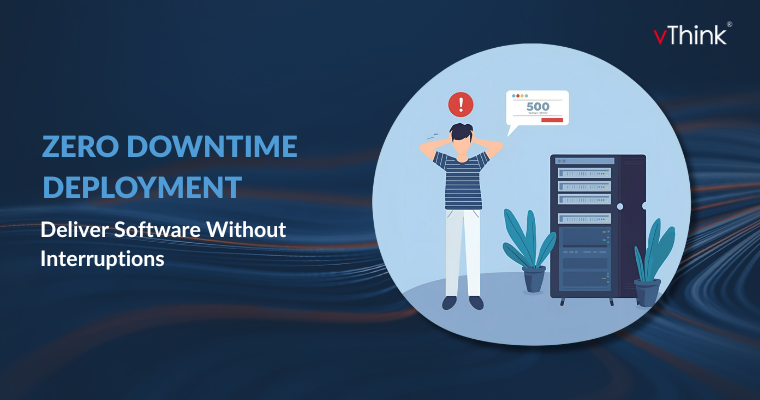Zero Downtime Deployment: Deliver Software Without Interruptions
In today's digital-first world, applications must be available 24/7 to meet customer expectations and business demands.

Why We Need Zero Downtime?
In today's digital-first world, applications must be available 24/7 to meet customer expectations and business demands. Any downtime—even for a few seconds—can lead to:
- Revenue loss
- Poor customer experience
- Reputational damage
- Breach of SLAs (Service-Level Agreements)
As systems scale and the frequency of releases increases, ensuring zero downtime becomes essential to maintain trust and deliver continuous value to users.
What is Zero Downtime Deployment?
Zero Downtime Deployment (ZDD) is a deployment strategy that ensures updates or changes to a live application occur without any interruption to its availability or user experience. In other words, users should not even notice that a deployment has taken place.
This is achieved by carefully managing traffic, infrastructure, and application state during the rollout process. ZDD is especially important for critical systems where even momentary outages can cause significant disruption.
How Does Zero Downtime Deployment Work?
Zero Downtime Deployment relies on a combination of deployment techniques, infrastructure readiness, and monitoring. Here’s how it generally works:
- Preparation: The new version is deployed in parallel with the current version in a separate environment.
- Traffic Management: Traffic is gradually or instantly shifted to the new version using load balancers.
- Validation: Real-time monitoring is used to detect any anomalies or failures.
- Rollback (if needed): If problems arise, the system can quickly revert to the previous version. These steps minimize risk while ensuring continuous availability for end users.
The Challenge: Deployment Without Downtime
Traditional deployments often involve taking down a service, updating it, and restarting it. While this may be acceptable during off-hours in low-traffic environments, it becomes a nightmare in high-availability systems. A few seconds of downtime can lead to: - Lost revenue - Broken user sessions - Negative brand impact The real challenge is how to deploy updates safely and seamlessly while maintaining application availability. This becomes more complex in distributed systems, microservices, and cloud-native architectures.
The Solution: Zero Downtime Deployment (ZDD)
Zero Downtime Deployment refers to a deployment method that ensures an application remains fully available while updates are being rolled out. It involves advanced release strategies, infrastructure automation, and continuous monitoring to avoid service interruptions.
Key Strategies for Zero Downtime Deployment
1. Blue-Green Deployment
Blue-Green deployment is a strategy where two identical production environments run side by side:
- Blue: The current production version.
- Green: The new version being deployed.
Once the green environment is fully tested, the router or load balancer switches all traffic from blue to green instantly. If an issue is detected, traffic can be routed back to blue.
2. Canary Deployment
A canary deployment involves releasing the new version to a small subset of users first. Performance and error metrics are observed in real time. If everything looks good, traffic will gradually increase.
3. Rolling Updates
A rolling update replaces instances of an application one at a time or in small batches. This ensures that some instances always remain available to serve users.
4. Feature Flags
Feature flags allow code to be deployed with new functionality disabled. The feature is then enabled for specific users, regions, or time windows via configuration.
5. Load Balancer Health Checks
A smart load balancer plays a critical role in zero downtime strategies. During deployment:
- Updated instances are marked as “unhealthy”
- Load balancer removes them from routing
- Once ready, they’re marked “healthy” and reintroduced.
The Hidden Complexity: Database Changes
One of the most overlooked challenges in ZDD is handling database migrations. To deploy database changes with zero downtime:
- Use non-breaking, backward-compatible changes
- Perform versioned, step-by-step migrations
- Decouple schema changes from logic changes
Tools That Power ZDD
Here are some tools widely used in the industry to implement zero downtime deployment:
CI/CD Orchestration: ArgoCD, Spinnaker, Jenkins X
Kubernetes Deployment: Helm, Kustomize, Istio
Feature Flags: LaunchDarkly, Flagsmith, Unleash
Observability: Prometheus, Grafana, Datadog
API Gateways / Load Balancers: NGINX, Envoy, AWS ALB
Infrastructure: Terraform, Pulumi
Real-World Use Cases
- E-commerce platforms pushing frequent updates without losing orders
- Banking apps releasing security patches with no service interruptions
- Mobile backends launching features while supporting old app versions
- Gaming systems rolling out content to global players in real-time
Final Thoughts
In modern DevOps practices, Zero Downtime Deployment is not optional — it's expected. Customers, clients, and stakeholders count on systems being available 24/7. By adopting the right deployment strategies, tools, and culture, engineering teams can confidently ship updates without fear.
Whether you're using containers, microservices, or monoliths, the goal remains the same: deliver value faster, with stability and trust.
Explore More
- Kubernetes Rolling Updates Documentation: https://kubernetes.io/docs/tutorials/kubernetes-basics/update/update-intro/
- LaunchDarkly for Feature Flags: https://launchdarkly.com/
- Blue-Green Deployments on AWS: https://docs.aws.amazon.com/elasticbeanstalk/latest/dg/using-features.deploy-existing-version.html
Best Tools for Zero Downtime Deployment
There’s no one-size-fits-all, but the best tools depend on your stack (Kubernetes, VMs, serverless), your release strategy (canary, blue-green), and how mature your DevOps practices are. Below is a curated list of the top tools categorized by use case, along with which ones are best for zero downtime deployment:
Top Tools by Use Case
CI/CD Pipelines
- Argo CD: GitOps-based Kubernetes deployments. Declarative, safe rollouts.
- Spinnaker: Ideal for large-scale, multi-cloud environments.
- GitHub Actions: Great for small to medium teams.
Feature Flags
- LaunchDarkly: Enterprise-grade, gradual rollout, A/B testing.
- Unleash: Lightweight, open-source, flexible.
- Flagsmith: Easy API support and multi-environment control.
Container Orchestration
- Kubernetes: Native rolling updates and health checks.
- Helm: Simplifies Kubernetes deployment via charts.
Load Balancing
- NGINX + Consul: Ideal for on-prem or hybrid setups.
- AWS ALB / GCP Load Balancer: Native health check and routing support.
Infrastructure as Code
- Terraform: Automates infrastructure, ideal for ZDD scenarios.
- Pulumi: Code-first multi-cloud infrastructure tool.
Monitoring & Observability
- Prometheus + Grafana: Real-time metrics and dashboards.
- Datadog: Full-stack observability with deployment tracking.
- New Relic: Supports deployment markers and app performance monitoring.
Top Picks by Deployment Strategy
- Blue-Green Deployment: Spinnaker, Terraform, AWS CodeDeploy
- Canary Releases: Argo Rollouts, LaunchDarkly, Flagger
- Rolling Updates: Kubernetes (native), Helm
- Feature Toggles: LaunchDarkly (enterprise), Unleash (OSS)
- Monitoring Rollouts: Prometheus + Grafana, Datadog
Pro Tips
- Use Argo CD + Argo Rollouts if you're Kubernetes-native.
- Use Spinnaker if you manage multiple clouds or environments.
- Add feature flags to control risk at runtime even after deployment.
- Always combine with observability (Prometheus, Grafana, Datadog) to react quickly.



